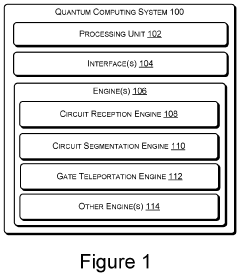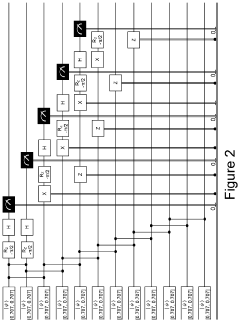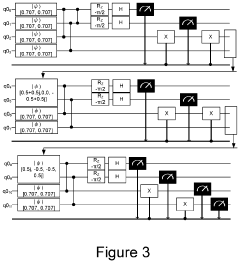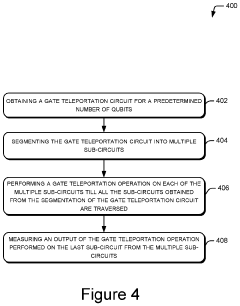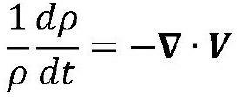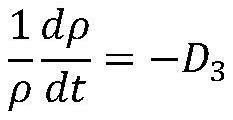Quantum Computing Techniques for Climate Modelling
JUL 17, 20259 MIN READ
Generate Your Research Report Instantly with AI Agent
Patsnap Eureka helps you evaluate technical feasibility & market potential.
Quantum Climate Modeling: Background and Objectives
Quantum computing has emerged as a revolutionary technology with the potential to transform various fields, including climate modeling. The intersection of quantum computing and climate science represents a frontier in scientific research, aiming to enhance our understanding of complex climate systems and improve predictive capabilities.
The development of quantum computing techniques for climate modeling is driven by the increasing need for more accurate and comprehensive climate predictions. Traditional climate models, while sophisticated, face limitations in processing power and computational efficiency when dealing with the vast complexities of Earth's climate system. Quantum computing offers a promising solution to these challenges by leveraging quantum mechanical principles to perform calculations that are infeasible for classical computers.
The primary objective of quantum climate modeling is to harness the unique properties of quantum systems, such as superposition and entanglement, to simulate and analyze climate phenomena with unprecedented precision and speed. This approach aims to address the computational bottlenecks encountered in conventional climate modeling, particularly in areas such as atmospheric dynamics, ocean circulation patterns, and long-term climate projections.
One of the key goals is to develop quantum algorithms specifically tailored for climate-related computations. These algorithms seek to optimize the representation of climate data in quantum states and exploit quantum parallelism to process multiple climate scenarios simultaneously. By doing so, researchers hope to achieve significant speedups in climate simulations and enable more detailed analyses of climate variables and their interactions.
Another crucial objective is to enhance the resolution and accuracy of climate models. Quantum computing techniques have the potential to incorporate a wider range of climate factors and their complex interrelationships, leading to more comprehensive and reliable climate predictions. This increased precision is particularly valuable for studying extreme weather events, regional climate variations, and long-term climate trends.
The integration of quantum computing into climate modeling also aims to improve our ability to assess and mitigate the impacts of climate change. By providing more accurate projections of future climate scenarios, quantum-enhanced models can inform policy decisions, guide adaptation strategies, and support the development of effective climate mitigation measures.
As the field of quantum climate modeling evolves, researchers are exploring various quantum computing architectures and approaches, including quantum annealing, quantum circuit models, and hybrid quantum-classical systems. The ultimate goal is to create a new generation of climate models that can leverage the full potential of quantum computing to address the pressing challenges of climate change and environmental sustainability.
The development of quantum computing techniques for climate modeling is driven by the increasing need for more accurate and comprehensive climate predictions. Traditional climate models, while sophisticated, face limitations in processing power and computational efficiency when dealing with the vast complexities of Earth's climate system. Quantum computing offers a promising solution to these challenges by leveraging quantum mechanical principles to perform calculations that are infeasible for classical computers.
The primary objective of quantum climate modeling is to harness the unique properties of quantum systems, such as superposition and entanglement, to simulate and analyze climate phenomena with unprecedented precision and speed. This approach aims to address the computational bottlenecks encountered in conventional climate modeling, particularly in areas such as atmospheric dynamics, ocean circulation patterns, and long-term climate projections.
One of the key goals is to develop quantum algorithms specifically tailored for climate-related computations. These algorithms seek to optimize the representation of climate data in quantum states and exploit quantum parallelism to process multiple climate scenarios simultaneously. By doing so, researchers hope to achieve significant speedups in climate simulations and enable more detailed analyses of climate variables and their interactions.
Another crucial objective is to enhance the resolution and accuracy of climate models. Quantum computing techniques have the potential to incorporate a wider range of climate factors and their complex interrelationships, leading to more comprehensive and reliable climate predictions. This increased precision is particularly valuable for studying extreme weather events, regional climate variations, and long-term climate trends.
The integration of quantum computing into climate modeling also aims to improve our ability to assess and mitigate the impacts of climate change. By providing more accurate projections of future climate scenarios, quantum-enhanced models can inform policy decisions, guide adaptation strategies, and support the development of effective climate mitigation measures.
As the field of quantum climate modeling evolves, researchers are exploring various quantum computing architectures and approaches, including quantum annealing, quantum circuit models, and hybrid quantum-classical systems. The ultimate goal is to create a new generation of climate models that can leverage the full potential of quantum computing to address the pressing challenges of climate change and environmental sustainability.
Market Analysis for Quantum-Enhanced Climate Simulations
The market for quantum-enhanced climate simulations is experiencing rapid growth, driven by the increasing need for more accurate and detailed climate models to address global environmental challenges. As climate change continues to impact various sectors of the economy, there is a growing demand for advanced simulation tools that can provide more precise predictions and insights into climate patterns, extreme weather events, and long-term environmental trends.
The potential market for quantum-enhanced climate simulations spans across multiple industries and sectors. Government agencies and research institutions are primary stakeholders, investing heavily in advanced climate modeling technologies to inform policy decisions and adaptation strategies. The global market for climate change consulting, which includes climate modeling and risk assessment, is projected to reach significant growth in the coming years, with quantum computing playing an increasingly important role.
Private sector industries, such as agriculture, energy, insurance, and infrastructure, are also showing keen interest in quantum-enhanced climate simulations. These sectors require more accurate climate predictions to assess risks, optimize operations, and develop long-term strategies. For instance, the insurance industry is particularly interested in improved climate modeling to better assess and price climate-related risks.
The market for quantum computing in climate modeling is closely tied to the overall quantum computing market, which is expected to grow substantially in the next decade. As quantum hardware and software capabilities advance, the potential applications in climate science are likely to expand, creating new market opportunities.
Several factors are driving the demand for quantum-enhanced climate simulations. First, the increasing frequency and severity of extreme weather events have heightened the need for more accurate climate predictions. Second, the growing complexity of climate models requires more computational power, which quantum computing can potentially provide. Third, there is a rising awareness among businesses and governments about the economic impacts of climate change, leading to increased investment in advanced modeling tools.
However, the market also faces challenges. The high cost of quantum computing infrastructure and the scarcity of skilled professionals in both quantum computing and climate science are significant barriers to widespread adoption. Additionally, the technology is still in its early stages, and practical, large-scale applications in climate modeling are yet to be fully realized.
Despite these challenges, the market outlook for quantum-enhanced climate simulations remains positive. As quantum computing technology matures and becomes more accessible, its integration into climate modeling is expected to accelerate. This will likely lead to the development of new products and services in climate risk assessment, environmental impact analysis, and climate-adaptive planning, creating a robust and diverse market ecosystem.
The potential market for quantum-enhanced climate simulations spans across multiple industries and sectors. Government agencies and research institutions are primary stakeholders, investing heavily in advanced climate modeling technologies to inform policy decisions and adaptation strategies. The global market for climate change consulting, which includes climate modeling and risk assessment, is projected to reach significant growth in the coming years, with quantum computing playing an increasingly important role.
Private sector industries, such as agriculture, energy, insurance, and infrastructure, are also showing keen interest in quantum-enhanced climate simulations. These sectors require more accurate climate predictions to assess risks, optimize operations, and develop long-term strategies. For instance, the insurance industry is particularly interested in improved climate modeling to better assess and price climate-related risks.
The market for quantum computing in climate modeling is closely tied to the overall quantum computing market, which is expected to grow substantially in the next decade. As quantum hardware and software capabilities advance, the potential applications in climate science are likely to expand, creating new market opportunities.
Several factors are driving the demand for quantum-enhanced climate simulations. First, the increasing frequency and severity of extreme weather events have heightened the need for more accurate climate predictions. Second, the growing complexity of climate models requires more computational power, which quantum computing can potentially provide. Third, there is a rising awareness among businesses and governments about the economic impacts of climate change, leading to increased investment in advanced modeling tools.
However, the market also faces challenges. The high cost of quantum computing infrastructure and the scarcity of skilled professionals in both quantum computing and climate science are significant barriers to widespread adoption. Additionally, the technology is still in its early stages, and practical, large-scale applications in climate modeling are yet to be fully realized.
Despite these challenges, the market outlook for quantum-enhanced climate simulations remains positive. As quantum computing technology matures and becomes more accessible, its integration into climate modeling is expected to accelerate. This will likely lead to the development of new products and services in climate risk assessment, environmental impact analysis, and climate-adaptive planning, creating a robust and diverse market ecosystem.
Current Challenges in Quantum Climate Modeling
Quantum computing techniques for climate modeling face several significant challenges that hinder their widespread adoption and effectiveness. One of the primary obstacles is the limited availability of quantum hardware with sufficient qubit capacity and coherence times to handle the complex calculations required for climate simulations. Current quantum systems struggle to maintain quantum states for extended periods, which is crucial for running lengthy climate model computations.
Another major challenge lies in the development of quantum algorithms specifically tailored for climate modeling. While quantum algorithms have shown promise in certain computational tasks, translating traditional climate models into quantum-compatible formats remains a complex undertaking. This process requires not only a deep understanding of quantum mechanics but also expertise in climate science and computational fluid dynamics.
The issue of error correction in quantum systems poses a significant hurdle for climate modeling applications. Climate models demand high precision and accuracy, but quantum computers are inherently prone to errors due to environmental interference and imperfect control mechanisms. Developing robust error correction techniques that can maintain the integrity of quantum calculations over extended simulation periods is crucial for reliable climate predictions.
Data integration and preprocessing present another set of challenges. Climate models rely on vast amounts of observational data from various sources. Efficiently encoding this classical data into quantum states and developing quantum algorithms that can process this information effectively is an ongoing area of research. The quantum-classical interface, where data is transferred between classical and quantum systems, remains a bottleneck in terms of speed and efficiency.
Scalability is a critical concern in quantum climate modeling. As climate models become more sophisticated, incorporating more variables and higher resolutions, the computational requirements grow exponentially. Scaling quantum systems to meet these demands while maintaining coherence and minimizing errors is a significant technical challenge that researchers are actively addressing.
The lack of standardized benchmarks and validation methods for quantum climate models also poses difficulties. Comparing the performance and accuracy of quantum-based simulations with classical models is essential for building confidence in the new technology. However, establishing fair and comprehensive benchmarks that account for the unique characteristics of quantum systems is an ongoing challenge in the field.
Lastly, the interdisciplinary nature of quantum climate modeling requires collaboration between quantum physicists, climate scientists, and computer scientists. Bridging the knowledge gap between these disciplines and fostering effective communication and cooperation is crucial for advancing the field. This collaborative challenge extends to the development of user-friendly tools and interfaces that allow climate scientists to leverage quantum computing capabilities without requiring extensive quantum physics expertise.
Another major challenge lies in the development of quantum algorithms specifically tailored for climate modeling. While quantum algorithms have shown promise in certain computational tasks, translating traditional climate models into quantum-compatible formats remains a complex undertaking. This process requires not only a deep understanding of quantum mechanics but also expertise in climate science and computational fluid dynamics.
The issue of error correction in quantum systems poses a significant hurdle for climate modeling applications. Climate models demand high precision and accuracy, but quantum computers are inherently prone to errors due to environmental interference and imperfect control mechanisms. Developing robust error correction techniques that can maintain the integrity of quantum calculations over extended simulation periods is crucial for reliable climate predictions.
Data integration and preprocessing present another set of challenges. Climate models rely on vast amounts of observational data from various sources. Efficiently encoding this classical data into quantum states and developing quantum algorithms that can process this information effectively is an ongoing area of research. The quantum-classical interface, where data is transferred between classical and quantum systems, remains a bottleneck in terms of speed and efficiency.
Scalability is a critical concern in quantum climate modeling. As climate models become more sophisticated, incorporating more variables and higher resolutions, the computational requirements grow exponentially. Scaling quantum systems to meet these demands while maintaining coherence and minimizing errors is a significant technical challenge that researchers are actively addressing.
The lack of standardized benchmarks and validation methods for quantum climate models also poses difficulties. Comparing the performance and accuracy of quantum-based simulations with classical models is essential for building confidence in the new technology. However, establishing fair and comprehensive benchmarks that account for the unique characteristics of quantum systems is an ongoing challenge in the field.
Lastly, the interdisciplinary nature of quantum climate modeling requires collaboration between quantum physicists, climate scientists, and computer scientists. Bridging the knowledge gap between these disciplines and fostering effective communication and cooperation is crucial for advancing the field. This collaborative challenge extends to the development of user-friendly tools and interfaces that allow climate scientists to leverage quantum computing capabilities without requiring extensive quantum physics expertise.
Existing Quantum Algorithms for Climate Simulations
01 Quantum Circuit Design and Optimization
This technique focuses on designing and optimizing quantum circuits to improve the efficiency and performance of quantum algorithms. It involves developing methods for reducing gate count, minimizing circuit depth, and enhancing qubit utilization. Advanced circuit design techniques aim to mitigate the effects of noise and decoherence in quantum systems.- Quantum Circuit Design and Optimization: This technique focuses on designing and optimizing quantum circuits to improve the efficiency and performance of quantum algorithms. It involves developing new circuit architectures, reducing gate counts, and minimizing error rates in quantum computations.
- Quantum Error Correction and Fault Tolerance: This area addresses the challenge of maintaining quantum information coherence by developing error correction codes and fault-tolerant quantum computing methods. It aims to mitigate the effects of decoherence and improve the reliability of quantum computations.
- Quantum-Classical Hybrid Algorithms: This approach combines classical and quantum computing techniques to solve complex problems. It leverages the strengths of both paradigms, using quantum processors for specific subroutines while classical computers handle other parts of the algorithm.
- Quantum Machine Learning and AI: This field explores the application of quantum computing to machine learning and artificial intelligence tasks. It involves developing quantum versions of classical machine learning algorithms and creating new quantum-inspired AI techniques.
- Quantum Simulation and Modeling: This technique uses quantum computers to simulate and model complex quantum systems that are difficult or impossible to study using classical computers. It has applications in materials science, chemistry, and other fields requiring accurate quantum mechanical simulations.
02 Quantum Error Correction and Fault Tolerance
Quantum error correction techniques are crucial for maintaining the integrity of quantum information in the presence of noise and decoherence. This involves developing and implementing error-correcting codes, fault-tolerant quantum gates, and protocols for detecting and correcting errors in quantum systems. These methods aim to extend the coherence time of qubits and improve the reliability of quantum computations.Expand Specific Solutions03 Quantum-Classical Hybrid Algorithms
This approach combines classical and quantum computing techniques to leverage the strengths of both paradigms. Hybrid algorithms typically involve using classical computers for pre-processing and post-processing tasks, while quantum processors handle specific computational steps that offer quantum advantage. This technique is particularly useful for near-term quantum devices with limited qubit counts and coherence times.Expand Specific Solutions04 Quantum Machine Learning and Optimization
This field explores the application of quantum computing to machine learning and optimization problems. Quantum machine learning algorithms aim to achieve speedups over classical counterparts for tasks such as classification, clustering, and pattern recognition. Quantum optimization techniques focus on solving complex optimization problems more efficiently using quantum annealing or quantum approximate optimization algorithms.Expand Specific Solutions05 Quantum Simulation and Chemistry
Quantum simulation techniques aim to model and simulate complex quantum systems that are intractable for classical computers. This includes simulating molecular and chemical processes for drug discovery, materials science, and understanding fundamental physics. Quantum chemistry algorithms focus on accurately calculating molecular properties and reaction dynamics using quantum computational methods.Expand Specific Solutions
Key Players in Quantum Climate Modeling Research
The quantum computing techniques for climate modelling field is in an early developmental stage, with significant potential for growth. The market size is expanding as governments and organizations increasingly recognize the importance of accurate climate predictions. Technologically, it's still evolving, with varying levels of maturity among key players. Companies like IBM and Fujitsu are leveraging their quantum computing expertise to advance climate modelling capabilities. Startups such as ClimateAI are focusing on AI-driven climate risk assessment, while academic institutions like Oxford University and Wuhan University contribute valuable research. The collaboration between quantum computing specialists and climate scientists is crucial for driving innovation in this emerging field.
International Business Machines Corp.
Technical Solution: IBM's quantum computing approach for climate modeling leverages their advanced quantum hardware and software stack. They utilize Qiskit, an open-source quantum computing framework, to develop quantum algorithms specifically tailored for climate simulations. IBM's quantum systems, such as their 127-qubit Eagle processor[1], provide the computational power needed for complex climate models. Their technique involves quantum-classical hybrid algorithms that can potentially solve certain climate modeling problems exponentially faster than classical computers. IBM has demonstrated the use of variational quantum algorithms to simulate atmospheric dynamics and has shown promising results in modeling chemical reactions relevant to climate science[2][3].
Strengths: Advanced quantum hardware, comprehensive software stack, and extensive research in quantum algorithms for climate science. Weaknesses: Current quantum systems still limited by noise and error rates, requiring significant error correction advancements for large-scale climate simulations.
Quantinuum LLC
Technical Solution: Quantinuum, formed from the merger of Honeywell Quantum Solutions and Cambridge Quantum, focuses on developing quantum algorithms and software for various applications, including climate modeling. Their approach utilizes trapped-ion quantum technology, known for its high-fidelity qubit operations. Quantinuum's System Model H1 quantum computer, powered by Honeywell, offers up to 20 fully connected qubits with high quantum volume[4]. For climate modeling, they are exploring quantum machine learning techniques to improve the accuracy of climate predictions and develop more efficient ways to simulate complex atmospheric and oceanic processes. Their quantum natural language processing capabilities are also being applied to analyze vast amounts of climate data[5].
Strengths: High-fidelity quantum hardware, strong focus on quantum software and algorithms, expertise in quantum machine learning. Weaknesses: Relatively lower qubit count compared to some competitors, which may limit the scale of climate simulations that can be performed in the near term.
Breakthrough Quantum Techniques for Climate Modeling
Techniques of quantum computing model
PatentPendingUS20240005189A1
Innovation
- Segmenting the gate teleportation circuit into multiple sub-circuits allows for sequential processing, reducing the complexity of entangled state preparation and minimizing the duration qubits need to be maintained in specific states, thereby enhancing operational efficiency and enabling reusability of qubits.
Numerical weather forecasting method and device, storage medium, and electronic device
PatentWO2024088092A1
Innovation
- Using quantum computing methods, by constructing quantum circuits used to solve the weather evolution process, obtain the initial values of the variables to be forecast and run the quantum circuits to obtain predicted values, using the characteristics of quantum computing to accelerate calculations.
Environmental Impact of Quantum Computing Centers
The environmental impact of quantum computing centers is a critical consideration as this technology advances and becomes more widely adopted for climate modeling and other applications. Quantum computers require extremely low temperatures to operate, often near absolute zero, necessitating significant energy consumption for cooling systems. This energy demand could potentially offset some of the environmental benefits gained from improved climate modeling capabilities.
Quantum computing centers also require specialized infrastructure and materials, including rare earth elements and superconducting materials. The extraction and processing of these resources can have substantial environmental consequences, including habitat destruction, water pollution, and greenhouse gas emissions. As demand for quantum computing grows, careful consideration must be given to sustainable sourcing and recycling practices for these materials.
The construction and operation of quantum computing facilities may also have localized environmental impacts. These centers require large, carefully controlled spaces with minimal vibration and electromagnetic interference. The development of such facilities could lead to land use changes and potential disruption of local ecosystems, particularly if located in sensitive areas.
However, it's important to balance these environmental costs against the potential benefits of quantum computing for climate science. More accurate and efficient climate models enabled by quantum computing could lead to better environmental policies, more effective mitigation strategies, and improved adaptation planning. This could result in significant positive environmental outcomes that may outweigh the localized impacts of quantum computing centers.
Energy efficiency improvements in quantum computing technology may also help mitigate some of these environmental concerns. Research is ongoing into more energy-efficient cooling methods, such as photonic quantum computing, which could operate at higher temperatures. Additionally, the integration of renewable energy sources and advanced energy management systems in quantum computing facilities could help reduce their carbon footprint.
As quantum computing for climate modeling advances, it will be crucial to conduct comprehensive life cycle assessments of these systems. This will enable a more accurate understanding of their net environmental impact and inform strategies to minimize negative effects while maximizing the benefits for climate science and environmental protection.
Quantum computing centers also require specialized infrastructure and materials, including rare earth elements and superconducting materials. The extraction and processing of these resources can have substantial environmental consequences, including habitat destruction, water pollution, and greenhouse gas emissions. As demand for quantum computing grows, careful consideration must be given to sustainable sourcing and recycling practices for these materials.
The construction and operation of quantum computing facilities may also have localized environmental impacts. These centers require large, carefully controlled spaces with minimal vibration and electromagnetic interference. The development of such facilities could lead to land use changes and potential disruption of local ecosystems, particularly if located in sensitive areas.
However, it's important to balance these environmental costs against the potential benefits of quantum computing for climate science. More accurate and efficient climate models enabled by quantum computing could lead to better environmental policies, more effective mitigation strategies, and improved adaptation planning. This could result in significant positive environmental outcomes that may outweigh the localized impacts of quantum computing centers.
Energy efficiency improvements in quantum computing technology may also help mitigate some of these environmental concerns. Research is ongoing into more energy-efficient cooling methods, such as photonic quantum computing, which could operate at higher temperatures. Additionally, the integration of renewable energy sources and advanced energy management systems in quantum computing facilities could help reduce their carbon footprint.
As quantum computing for climate modeling advances, it will be crucial to conduct comprehensive life cycle assessments of these systems. This will enable a more accurate understanding of their net environmental impact and inform strategies to minimize negative effects while maximizing the benefits for climate science and environmental protection.
Quantum-Classical Hybrid Approaches for Climate Modeling
Quantum-classical hybrid approaches for climate modeling represent a promising frontier in computational climate science. These methods leverage the strengths of both quantum and classical computing systems to address the complex challenges of climate simulation and prediction. The hybrid approach typically involves using quantum algorithms to solve specific computationally intensive sub-problems within a larger classical climate model.
One key area where quantum-classical hybrid methods show potential is in the optimization of parameterization schemes used in climate models. These schemes are crucial for representing small-scale processes that cannot be directly resolved by the model grid. Quantum optimization algorithms, such as the Quantum Approximate Optimization Algorithm (QAOA), can be employed to fine-tune these parameterizations, potentially leading to more accurate representations of cloud formation, precipitation patterns, and other critical climate processes.
Another application of hybrid approaches is in the realm of data assimilation, where observational data is integrated into climate models to improve forecasts. Quantum-inspired algorithms, such as quantum annealing, can be used to solve complex optimization problems associated with data assimilation, potentially enhancing the accuracy and efficiency of climate predictions.
Quantum-classical hybrid methods also show promise in addressing the computational bottlenecks associated with solving partial differential equations (PDEs) that form the core of many climate models. Quantum algorithms for linear systems of equations, such as the HHL algorithm, can be integrated into classical PDE solvers to accelerate certain computations, particularly those involving large, sparse matrices.
Furthermore, hybrid approaches are being explored for improving the representation of quantum mechanical processes in climate models. For instance, quantum chemistry calculations, which are relevant for atmospheric chemistry simulations, can be performed more efficiently using quantum computers and then integrated into classical climate models.
While quantum-classical hybrid approaches for climate modeling are still in their early stages, they represent a significant opportunity for advancing the field. As quantum hardware continues to improve and quantum algorithms become more sophisticated, these hybrid methods are expected to play an increasingly important role in enhancing the accuracy, efficiency, and scope of climate simulations.
One key area where quantum-classical hybrid methods show potential is in the optimization of parameterization schemes used in climate models. These schemes are crucial for representing small-scale processes that cannot be directly resolved by the model grid. Quantum optimization algorithms, such as the Quantum Approximate Optimization Algorithm (QAOA), can be employed to fine-tune these parameterizations, potentially leading to more accurate representations of cloud formation, precipitation patterns, and other critical climate processes.
Another application of hybrid approaches is in the realm of data assimilation, where observational data is integrated into climate models to improve forecasts. Quantum-inspired algorithms, such as quantum annealing, can be used to solve complex optimization problems associated with data assimilation, potentially enhancing the accuracy and efficiency of climate predictions.
Quantum-classical hybrid methods also show promise in addressing the computational bottlenecks associated with solving partial differential equations (PDEs) that form the core of many climate models. Quantum algorithms for linear systems of equations, such as the HHL algorithm, can be integrated into classical PDE solvers to accelerate certain computations, particularly those involving large, sparse matrices.
Furthermore, hybrid approaches are being explored for improving the representation of quantum mechanical processes in climate models. For instance, quantum chemistry calculations, which are relevant for atmospheric chemistry simulations, can be performed more efficiently using quantum computers and then integrated into classical climate models.
While quantum-classical hybrid approaches for climate modeling are still in their early stages, they represent a significant opportunity for advancing the field. As quantum hardware continues to improve and quantum algorithms become more sophisticated, these hybrid methods are expected to play an increasingly important role in enhancing the accuracy, efficiency, and scope of climate simulations.
Unlock deeper insights with Patsnap Eureka Quick Research — get a full tech report to explore trends and direct your research. Try now!
Generate Your Research Report Instantly with AI Agent
Supercharge your innovation with Patsnap Eureka AI Agent Platform!
